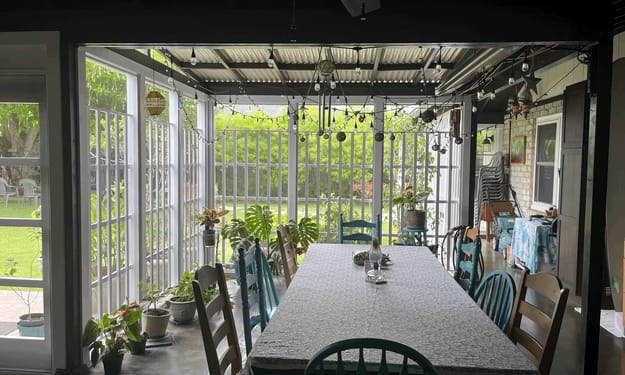
Hi guys, I'm Twiine Ivan and today let's prepare a bowl of ramen
We started from 6 pounds of pork neck bones. You can find pork neck bones really easily at any Asian grocery store or ask your butcher shop; they might have some. Soak the pork in cold water for one hour; this process will help to get rid of a lot of blood from the pork meat and the bones. Discard the water and bring enough water to boil and blanch those pork bones for five to seven minutes. Drain and discard the water. Some of you might worry, "Oh, those are all the flavors you're throwing away." No, we are throwing away all those bone bits, blood, and bodies that come from the meat and the bones. They are dirty flavors that we do not want in our broth.
The key point of Kyoto Shoyu Ramen, or all Japanese ramen, is super deep-flavored yet super duper clean as well. So this step is necessary. Wash the bones under running cold water. You can get another pot out or just wash the same pot real quick like I did and place those clean pork bones into the pot.
Now let's add lots of flavor fragrance vegetables: 2 ounces of sliced ginger, 2 bulbs of garlic cut in half, 1 large leek cut in half and wash it really well because the leek contains a lot of dust and mud in between the layers, so make sure you wash it really well. And then add it to the pot, a large piece of kombu, or dried kelp, is about 1 and a half ounces. If your kombu has a lot of white stuff on the surface, go ahead and swipe it out with a towel. Lastly, 1 and a half tablespoons of chicken powder. And this is a little bit of my cheating. Like, I'm making home-style, instead of making another whole pot of chicken stock. This is, you know, making it easy at home part, okay? And pour 24 cups of cold water. Put it to boil over high heat with no cover. And for the first 15 minutes of hard boiling, go ahead and skim all the scums on the surface. And at this point, remember not to stir the soup because we want to get rid of all the scums coming up to the surface. Because if you stir the soup, it will all sink down under the soup again, and we don't want that to happen.
Now, cover, reduce the heat to medium, and simmer for three hours.
After three hours of simmering the broth, this is the time to add the pork. Actually, pork meat for the char siu, to put it on top as a garnish on the ramen. You will need 2 pounds of pork shoulder or pork belly. And if you're using one big 2-pound chunk, then go ahead and simmer for an additional one hour. Or if you're using, like mine, two small pieces of 1 pound each, then go ahead and simmer about 30 to 45 minutes.
And meanwhile, the pork and the broth are finishing cooking, we are going to make tare, a mini sauce in Japanese. And in Japanese ramen shops, they actually do make this sauce separately and mix it with the broth later, right before they're serving the ramen.
I just added the ginger and the garlic into a little sauce pot. And now I'm going to add 1 and a half cups of soy sauce and 3/4 cup of sake. In Miso Ramen, there is many different types of ramen out there, and the most signature one is a Shoyu Ramen. Miso Ramen is the ramen just seasoned with only miso, very clean basic ramen broth. And Miso Ramen is seasoned with miso, and Shoyu Ramen is seasoned with soy sauce. That is what we are making today. That's why we need 1/2 cup of soy sauce today. And Tonkotsu is another type of ramen that is a creamy, milky broth. I think that's the most popular ramen in America. I'm going to share the recipe sometime soon too. So tune in.
Now, we are going to bring this tare to boil over high heat and let it keep hard boiling for 5 to 7 minutes.
Alright, I just removed my pork pieces from the broth. I boiled them about 30 minutes, and my tare is ready to go. It's cooling down, but obviously, you can tell the pork has no color outside at all. So what I'm gonna do is put a little bit of tare onto the pork so the pork will actually have a little bit of color around it. And if you want to, you can go ahead and make my char siu recipe for this ramen, but I really wanted to recreate how we tasted it in the Shoyu Ramen in Kyoto, the ramen shop. The pork char siu wasn't cooked separately and simmered in different sauce. It was actually like nothing against from the natural broth flavor. So I believe this is somewhat a very similar flavor that we had in Kyoto. So I'm just gonna move the pork around. See, a little bit of darker color actually makes this pork already look more yummy. Now, all we have to do is cool this pork in the refrigerator completely so it'll be easier for us to slice them thinly.
About the Creator
Enjoyed the story? Support the Creator.
Subscribe for free to receive all their stories in your feed. You could also pledge your support or give them a one-off tip, letting them know you appreciate their work.





Comments (1)
Thank you for sharing your culinary journey with us, Twiine Ivan.